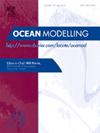Wind-driven exchange flow and inter-basin connectivity in a multi-inlet bay during hurricane and non-hurricane periods
IF 2.9
3区 地球科学
Q2 METEOROLOGY & ATMOSPHERIC SCIENCES
引用次数: 0
Abstract
This study quantifies wind-induced water volume exchanges through bay-ocean interfaces and among sub-bays of a multiple-inlet estuary, Biscayne Bay in Florida. The bay is elongated and oriented roughly in the north-south direction. Numerical simulations were conducted for both typical and extreme (Hurricane Irma) wind conditions. Results show that wind forcing accounts for 〈 10 % of total volume exchanges during typical winds but for 〉 60 % during hurricane conditions. Further, volume transport through seven inlets and five inter-basin transects is mainly driven by the North wind component (∼ parallel to the orientation of the bay). As a result, the major outflow through inlets is related to Ekman transport driven by southerly (or northward) winds. Except for the fifth inlet, volume transport through all the other six inlets is outward under southerly wind (R2>0.65). In contrast, southward inter-basin transports are mainly driven by northerly (or southward) wind and northward transports by southerly (or northward) wind. Inter-basin volume transport is highly related with the N-S wind (R2 >0.74), i.e., the northward/southward transport is in line with the southerly/northerly wind. Additionally, the forcing-response joint Empirical Orthogonal Function (EOF) analysis shows that Biscayne Bay exhibits only one predominant exchange pattern, which explains > 90 % under typical winds and > 80 % during hurricane winds.
飓风和非飓风期间多入口海湾的风驱动交换流和盆地间连通性
本研究量化了佛罗里达州比斯坎湾(Biscayne Bay)一个多入口河口的海湾-海洋界面和子海湾之间的风致水量交换。海湾呈细长状,大致面向南北方向。数值模拟了典型和极端(飓风Irma)风条件。结果表明,在典型风条件下,风强迫占总体积交换的10%以下,而在飓风条件下,风强迫占60%以上。此外,通过七个入口和五个盆地间横断面的体积运输主要由北风分量驱动(与海湾方向平行)。因此,通过入口的主要流出与南风(或北风)驱动的Ekman运输有关。除第5进气道外,其余6个进气道在南风条件下均为向外输送(R2>0.65)。南向的盆地间运输主要由北风(或南风)驱动,向北的盆地间运输主要由南风(或北风)驱动。盆地间体积输送与南南风高度相关(R2 >0.74),即向北/向南输送与南北风一致。此外,强迫-响应联合经验正交函数(EOF)分析表明,比斯坎湾仅表现出一种主要的交换模式,在典型风和飓风中分别解释了90%和80%。
本文章由计算机程序翻译,如有差异,请以英文原文为准。
求助全文
约1分钟内获得全文
求助全文
来源期刊

Ocean Modelling
地学-海洋学
CiteScore
5.50
自引率
9.40%
发文量
86
审稿时长
19.6 weeks
期刊介绍:
The main objective of Ocean Modelling is to provide rapid communication between those interested in ocean modelling, whether through direct observation, or through analytical, numerical or laboratory models, and including interactions between physical and biogeochemical or biological phenomena. Because of the intimate links between ocean and atmosphere, involvement of scientists interested in influences of either medium on the other is welcome. The journal has a wide scope and includes ocean-atmosphere interaction in various forms as well as pure ocean results. In addition to primary peer-reviewed papers, the journal provides review papers, preliminary communications, and discussions.
 求助内容:
求助内容: 应助结果提醒方式:
应助结果提醒方式:


